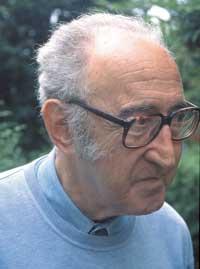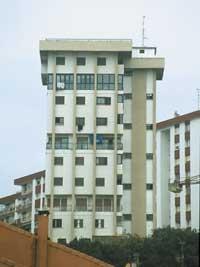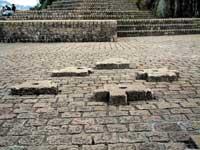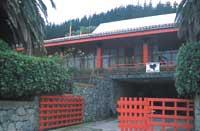Luis Peña Gantxegi: master of architecture
Why architect?

There are several reasons for this. First of all, we have to take into account the atmosphere of the house, because they saw well that I was an architect. In Oñati also lived an architect, very curious thing, because then the architects lived in the cities. His closeness, his knowledge would probably also help to make the decision. The beauty of the church, the university and the square of Oñati, the time I made in childhood in Markina – the opportunity to get to know the park of San Miguel de Arretxinaga, the park of Munibe and the neo-Gothic church of Xemein – and the years of Mutriku, in which my parents were from there… it seems that all directed me to study architecture. All those places I loved.
Later, at the end of the baccalaureate studies in San Sebastian I had to go to the revalidation to Valladolid. The train stayed in Burgos and a friend and I visited the cathedral. Returning to the train, that landscape bothers me, brought me back, as when I first went to Madrid. Next to Donostia I found it very ugly. All this led me to learn architecture.
After studying architecture in Madrid, did you start working immediately?
Yes, here in Donostia. I was also in town hall for two years, but I didn't like anything and left it. It was an ugly, unpleasant and interest-free job.
Yes?
Well, many projects were presented poorly realized, bad from the architectural point of view, with many problems of property and ordinance… it was not a work of architect but of control, of concession and withdrawal of permits.
He is currently professor emeritus of the UPV. He has also been teaching, how about it?

The truth is that I do not like too much, I have no vocation. The problem is that when I was a teacher in Barcelona, teaching classes, we wanted to bring architecture studies here. As founder of the School of Architecture of San Sebastian, I have continued to work in the future, especially to be able to have adequate teachers, etc.
Art, mathematics, good taste, construction, imagination, design… what is architecture?
Well, that debate we're not going to solve neither you nor me nor anyone. If architecture enters art, architecture cannot have to do with mathematics and construction, it is something with its own life. But that is not so, because architecture is essential to materialize. If it doesn't take place, there are fantastic imaginary projects. Tindaya de Chillida's project can be a good example. There is the emptying of the mountain, but then another thing is if this is going to stand, if the engineers are going to do the calculations or if some architect can give it the definitive form. That is more architecture than sculpture, and there we see that the disciplines appear mixed.
Chillida is an artist, but in that project he also wants to be an architect; Oteiza has also traveled these paths. And sometimes these artists are not satisfied with their work, since construction or mathematics make slightly vary the shape of their works. Architecture has a lot to do with art, but with a certain commitment to society.
In that sense, does current architecture respond to the needs of society? That is, asked differently, nowadays it seems that architecture only fulfills an aesthetic function. In addition to drawing attention, are you looking for something else?
This type of criticism is often heard, that architects have forgotten society and try to do things for them, that what they do is closer to art than to the service that must be offered to society. To some extent it is true, many current architects regard architecture as the art of space. What happens is that it is very difficult for well-built, practical buildings to be both artistic. Good training helps a lot, but mastering construction or imagining innovations in structures is difficult.
Construction is now moving forward. We have new materials that we must use because they are the ones offered by the current industry, but with clear criteria: neither any material, nor any other material, but they must be used for the industry to advance.

New materials and techniques offer new possibilities?
Yes, they offer opportunities and are giving results. However, there are also techniques – from an artistic point of view – that use them improperly. The bullring of San Sebastian, for example, is a technically brilliant work, but other aspects can be questioned.
As the environment has mentioned. Should architects always keep it in mind?
That is basic. For the best architects, Gaudi, Frank Lloyd Wright, Le Corbusier, and Ludwig Mies van der Rohe, has been essential. If he had not had the vision of Gaudí's nature, for example, he would not have been able to build the Güell park; or if Frank Lloyd Wright had not taken it into account, he would hardly have made the waterfall house. Mira, his father, inventor of pret à porter, was one of those rich and took care of making the house to his son. With land of many square kilometers, Frank Lloyd Wright chose the most difficult place, the least devastating of nature, while nature itself wore the house. The same can be said of Le Corbusier, although it seems more serious. And what to say about the famous glass houses of Ludwig Mies van der Rohe, the buildings that enter and leave the landscape.
Now, you, what work are you doing?
I have a villa project for a notary in my hands. It is a tremendous project, with budget, but I have not found who builds it. People do not want such works, they want to make floors, 500-600 houses, townhouses –if they are many, better–, etc. I have contacted a friend architect that I have in Santander to see if there we find some builder, since there they become more chalets than here.


Which of the works you have done would you highlight?
I still very much like the house Imanolena of Mutriku, which is deteriorated inside. On the other hand, I have a frustration because it was a social failure. It ended badly, then they changed it, where there was a floor there are three currently… The Vista Alegre tower of Zarautz, this one you have in this booklet.
In the brochure I have seen that the Comb of the Wind of San Sebastian is also yours. Most people believe it is from Eduardo Chillida.
The sculptures, of course, are not mine. Otherwise there is an important part, from the beginning, but it is a work done in collaboration with Eduardo and it is not worth starting to discuss to what extent it is one and the other.
In this square is evident the integration with the environment. More than the influence of the shape of the square, it can be due to the choice of material. Is the material so important to give that feeling?
Yes, it is important. Wrinkles, color… these elements are very thought out. The question is more complex than it seems obvious, even if it seems easy. For example, integration with the hillside. We invented a water collection system, we collected the stone with an irregular hillside –with boulders– and at the same time we had to think about how to introduce the mountain under the square and transmit the sensation that goes to the island. If all these things are done well you notice and if they are done wrong you notice even more. Everything goes, things come together little by little and then I mean you see the result.
Peña Gantxegi Route Luis Peña Gantxegi (Oñati, 29-03-1926). Through his studies he spent his childhood between Oñati, Markina and Mutriku. After finishing his high school in San Sebastian, he studied architecture in Madrid. He finished his studies in 1959 and soon began working in San Sebastian. In 1976 he was at the School of Architecture of Barcelona and a year later, in 1977, he founded and directed the School of Architecture of San Sebastian. In 1988 he obtained the professorship of University and since 1991 he is professor emeritus. He has not hesitated to wonder what places should necessarily be visited in Euskal Herria: the capitals, “to see what was done well and, especially in the peripheral neighborhoods, what is being done wrong”. |





